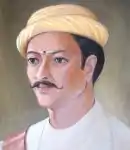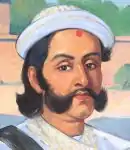| Mukhtiyar of Kingdom of Nepal नेपाल अधिराज्यको मुख्तियार | |
|---|---|
.jpg.webp) | |
| Style | Sri Mukhtiyar General Mukhtiyar Saheb |
| Residence | various (incl. Bag Durbar for Bhimsen Thapa) |
| Seat | Hanuman Dhoka Palace |
| Appointer | King of Nepal |
| Precursor | Damodar Pande (as Mul Kaji of Nepal) |
| Formation | 26 February 1806 |
| First holder | Rana Bahadur Shah |
| Final holder | Mathabarsingh Thapa |
| Abolished | 25 December 1843 |
| Succession | Mathabarsingh Thapa (as Prime Minister of Nepal) |
.svg.png.webp) |
|---|
|
|
Mukhtiyar (Nepali: मुख्तियार) was the position of head of executive of Kingdom of Nepal between 1806 and 1843. It was equivalent to Prime Minister of Nepal. There were 7 Mukhtiyars appointed between 1806 and 1843.
Meaning
Mukhtiyar is formed from two words: Mukhya and Akhtiyar. Mukhya means Chief[1] and Akhtiyar means Authority.[2] Altogether it means the "Executive Head of the State". Kumar Pradhan suggests that the word has Persian origin and denotes "competent-to-do" or broadly "Commander-in-Chief".[3]
History
In 1806, the self denounced King Rana Bahadur Shah was made Mukhtiyar (chief authority) and Bhimsen Thapa tried to implement his schemes through Rana Bahadur.[4] On the night of 25 April 1806, Sher Bahadur Shah, step-brother of Mukhtiyar in desperation drew a sword and killed Rana Bahadur Shah before being cut down by nearby courtiers, Bam Shah and Bal Narsingh Kunwar, also allies of Bhimsen.[5][6] It triggered the Bhandarkhal massacre on the royal garden.[7][8] On the grounds of the chaotic situation of the Bhandarkhal massacre, Bhimsen rose to the title of Mukhtiyar.[9] The position of Mukhtiyar was under Pajani (Annual Renewal) system. During the annual muster of 1833, King Rajendra Bikram Shah delayed the retainment of Bhimsen's own position as the Mukhtiyar.[10] On the false charge of murder of infant Prince Devendra on 1837, Bhimsen, his brother Ranbir Singh, his nephew Mathbar Singh, their families, the court physicians, Ekdev and Eksurya Upadhyay, and his deputy Bhajuman Baidya, with a few more of the nearest relatives of the Thapas were incarcerated, proclaimed outcasts, and their properties confiscated.[11][12][13][14] Immediately after the incarceration of the Thapas, a new government with joint Mukhtiyars was formed with Ranganath Paudel as the head of civil administration, and Dalbhanjan Pande and Rana Jang Pande as joint heads of military administration.[15] After about three months in power, under pressure from the opposing factions, the King removed Rana Jang as Mukhtiyar and Ranganath Paudel, who was favorably inclined towards the Thapas, was chosen as the sole Mukhtiyar.[16][17][18][19] However, Ranganath Poudel, finding himself unsupported by the King, resigned from the Mukhtiyari, which was then conferred on Pushkar Shah; but Puskhar Shah was only a nominal head, and the actual authority was bestowed on Ranajang Pande.[20] At the beginning of 1839, Ranjang Pande was made the sole Mukhtiyar.[21][22] but Ranajang's inability to control the general lawlessness in the country forced him to resign from the office, which was then conferred on Puskar Shah, based on Senior Queen Samrajya Lakshmi's recommendation.[23] There was also a brief army mutiny in June 1840.[24] Brian Hodgson sent an indiscriminating report of mutiny to Governor General and he demanded the dissolution of the reigning government. Pushkar Shah and his Pande associates were dismissed by the King, and Fateh Jung Shah was appointed Mukhtiyar in November 1840.[25] The Queen, seeking support of her own son's claims to the throne over those of Surendra, invited Mathabar Singh Thapa back after almost six years in exile.[26] He was greeted with a grand welcome and was offered to lead the government.[27] By December 1843, Mathabar Singh was appointed Prime Minister.[28] Thus, the first Mukhtiyar to title himself as a prime minister, as per the British convention, was Mathabar Singh Thapa.[29]
List of Mukhtiyars of Kingdom of Nepal
| No. | Portrait | Name (Birth–Death) |
Term of office | Political party | ||
|---|---|---|---|---|---|---|
| Took office | Left office | |||||
| 1 |  |
Rana Bahadur Shah (1775–1806) |
26 February 1806 | 26 April 1806 | Independent | |
| 2 | .jpg.webp) |
Bhimsen Thapa (1775–1839) |
1806 | 1837 | Independent | |
| 3 |  |
Rana Jang Pande (1789–1843) 1st time |
1837 | 1837 | Independent | |
| 4 |  |
Ranga Nath Poudyal (1773–?) 1st time |
1837 | 1838 | Independent | |
| 5 |  |
Chautariya Puskhar Shah (1784–1846) |
1838 | 1839 | Independent | |
| (3) |  |
Rana Jang Pande (1789–1843) 2nd time |
1839 | 1840 | Independent | |
| (4) |  |
Ranga Nath Poudyal (1773–?) 2nd time |
1840 | 1840 | Independent | |
| 6 |  |
Fateh Jung Shah (1805–1846) 1st time |
November 1840 | January 1843 | Independent | |
| 7 |  |
Mathabar Singh Thapa (1798–1845) |
November 1843 | 25 December 1843 | Independent | |
See also
References
- ↑ "English Translation of "मुख्य" - Collins Hindi-English Dictionary". www.collinsdictionary.com. Retrieved 26 March 2018.
- ↑ "English Translation of "अख़्तियार" - Collins Hindi-English Dictionary". www.collinsdictionary.com. Retrieved 26 March 2018.
- ↑ Pradhan 2012, glossary xv.
- ↑ Nepal 2007, pp. 60–61.
- ↑ Acharya 2012, p. 67.
- ↑ Nepal 2007, pp. 62–63.
- ↑ Acharya 2012, pp. 68–71.
- ↑ Nepal 2007, pp. 63–64.
- ↑ Acharya 2012, p. 71.
- ↑ Acharya 2012, p. 150.
- ↑ Nepal 2007, p. 105.
- ↑ Acharya 2012, p. 159.
- ↑ Acharya 1971, p. 13.
- ↑ Oldfield 1880, p. 310.
- ↑ Nepal 2007, p. 106.
- ↑ Acharya 2012, p. 160.
- ↑ Oldfield 1880, p. 311.
- ↑ Nepal 2007, p. 109.
- ↑ Pradhan 2012, p. 164.
- ↑ Oldfield 1880, p. 313.
- ↑ Nepal 2007, p. 110.
- ↑ Acharya 2012, pp. 161–162.
- ↑ Acharya 2012, p. 167.
- ↑ Acharya 2012, pp. 168–169.
- ↑ Acharya 2012, p. 170.
- ↑ Acharya 2012, pp. 177–178.
- ↑ Sharma, Balchandra (1976). Nepal ko Aitehasik Rooprekha. Varanasi: Krishna Kumari Devi. p. 295.
- ↑ Acharya 2012, pp. 11–12.
- ↑ Kandel 2011, p. 10.
Bibliography
- Acharya, Baburam (1971), "The Fall of Bhimsen Thapa and The Rise of Jang Bahadur Rana" (PDF), Regmi Research Series, Kathmandu, 3: 214–219
- Acharya, Baburam (2012), Acharya, Shri Krishna (ed.), Janaral Bhimsen Thapa : Yinko Utthan Tatha Pattan (in Nepali), Kathmandu: Education Book House, p. 228, ISBN 9789937241748
- Kandel, Devi Prasad (2011). Pre-Rana Administrative System. Chitwan: Siddhababa Offset Press. p. 95.
- Nepal, Gyanmani (2007), Nepal ko Mahabharat (in Nepali) (3rd ed.), Kathmandu: Sajha, p. 314, ISBN 9789993325857
- Oldfield, Henry Ambrose (1880), Sketches from Nipal, Vol 1, vol. 1, London: W.H. Allan & Co.
- Pemble, John (2009), "Forgetting and remembering Britain's Gurkha War", Asian Affairs, 40 (3): 361–376, doi:10.1080/03068370903195154
- Pradhan, Kumar L. (2012), Thapa Politics in Nepal: With Special Reference to Bhim Sen Thapa, 1806–1839, New Delhi: Concept Publishing Company, p. 278, ISBN 9788180698132